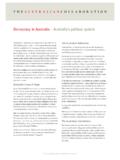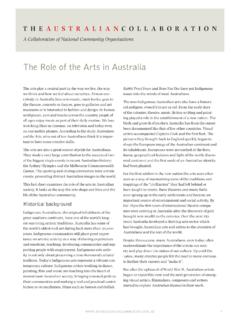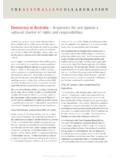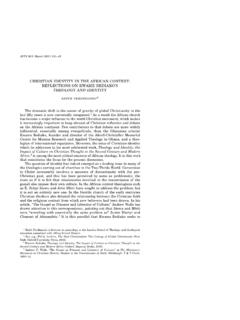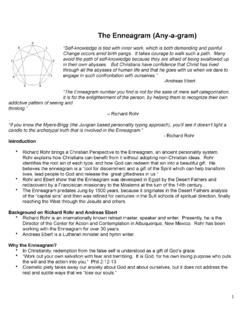Transcription of TheAusTrAl iAnCollborA ATion
1 T h e A u s t r a l i a n C o l l a b o r at i o n A Collaboration of National Community Organisations Religion in Australia Religion has been defined by the Australian High court as Congregationalist, Lutheran, Baptist and Methodist faiths a complex of beliefs and practices which point to a set of were all present in Australia. Christianity has remained values and an understanding of the meaning of existence . the dominant religious tradition in Australia, with sectar- The faith communities that practice religion in Australia ian rivalry - notably between Irish Catholics and English exhibit many different structures of belief, practice and Protestants - being a feature of Australian life until the lat- organisation that frame their attitudes to life as a whole. ter part of the twentieth century. In Australia, religion is usually associated with a belief in Jewish people first came to Australia aboard the First Fleet God (for instance, as in the Jewish, Christian or Islamic in 1788 and many more arrived as refugees after World traditions).
2 Religion also includes an awareness of the War II. The first evidence of Buddhist settlement dates to sacred, supernatural or divine (as in Buddhism or Hindu- 1848 when Chinese miners arrived in Australia following ism, for example). While religion is often regarded as a the discovery of gold. Immigration from South East Asia path to moral truth or social well-being, non-religious peo- since the Vietnam War has also increased the numbers of ple may aspire to these goals in different ways (for exam- Buddhists in Australia. Muslims and Hindus came to Aus- ple, via secular humanism). Sociologists tend to view tralia throughout the nineteenth century to work on cot- religion as a social construction designed to give meaning ton and sugar plantations and as cameleers, divers and to the causes, consequences and purpose of existence and sailors. Muslim numbers have increased steadily in more to offer comfort in the face of life's uncertainties. recent times as a result of civil strife in Lebanon, Iraq, Iran and Afghanistan and due to immigration, more generally, The development of a multifaith Australia from Turkey, Egypt and other parts of the Middle East.
3 For more than 40,000 years prior to European settlement, Changing religious affiliations Indigenous Australians followed belief systems which were embedded in complex oral traditions and based on According to the ABS, in 1901, the year of Federation, 40. the forces of nature, ancestral influence and reverence for per cent of the Australian population identified themselves the land. Integral to Indigenous belief systems were Crea- as Anglican, 23 per cent as Catholic and 34 per cent as tion stories, notably Aboriginal stories of the Dreamtime', other Christian'. Approximately 1 per cent identified which combined knowledge, customary law and beliefs themselves as non-Christian'. Similarly, the first census in about the origin of the land and its people. A belief in the 1911 showed that 96 per cent of Australians identified interconnectedness of spiritual, human and natural phe- themselves as Christian. nomena continues to permeate Indigenous mythology, After the end of World War II, and with changes to the ceremonial life and artistic traditions.
4 The first known White Australia policy in that period, there was a flow of contacts between Indigenous people and outsiders with migrants from a number of different countries and a con- different belief systems reach back to the sixteenth cen- siderable diversification of religious affiliation in Australia. tury, when Muslim fishermen and traders from the east Orthodox Christians came from Greece and the Middle Indonesian archipelago visited mainland Australia. East, and Catholics came from Italy, Hungary, Poland and European settlement in Australia brought with it chap- Vietnam. Alongside these churches, Pentecostal, Inde- lains of the Church of England (now the Anglican church). pendent Chinese and other ethnic churches have also Other Christian churches arrived as transportation and emerged. In Melbourne and Sydney today there are immigration continued so that by the early nineteenth churches of every Christian tradition. century, the various Roman Catholic, Presbyterian, 1.
5 T h e A u s t r a l i a n C o l l a b o r at i o n Table 1: Major Religious Affiliations Christian Other No Not stated/ Total religions religion' inadequately Anglican Catholic Other Total described (Christian) (Christianity). Census % % % % % % % '000. year 1901 (a) 3, 1911 (a) 4, 1921 (a) 5, 1933 6, 1947 7, 1954 8, 1961 10, 1966 11, 1971 12, 1976 13, 1981 14, 1986 15, 1991 16, 1996 17, 2001 18, 2006 19, 2011 (a) 21, (a) Includes respondents who objected to stating their religious affiliation. Source: ABS Census of Population and Housing. Please note that data for 2011 was sourced from the ABS article Reflecting a Nation: Stories from the 2011 Census. Table 1 shows religious affiliations at each census since practice; for example, people who identify as Jewish may Federation. not necessarily be practising Jews. Among the most striking findings of the 2011 Census is Other key developments have been the continuation of a the growth in the number of people affiliating with non- long-standing trend of decline in Christian affiliation (from Christian religions, which rose from per cent of the 96 per cent in 1911, to 68 per cent in 2001 and 61 per cent total population in 2001, to per cent in 2011.)
6 Hindu- in 2011) and the growing proportion of Australians who ism, Islam and Buddhism were the fastest growing of these identify as having no religion' (from 15 per cent in 2001. faiths, with increases of 189, 69 and 48 per cent respec- to 22 per cent in 2011). Among the Christian faiths, Angli- tively. These trends reflect changes in the countries of ori- canism recorded the most significant decline, from 21 per gin of recent immigrants, among whom these religions are cent in 2001 to 17 per cent in 2011, while Pentecostal affil- more highly represented than in the total population of iation rose from 1 to per cent in the same period. Young Australia. It should be noted, however, that religion is people (aged 15-34) were the most likely to profess no faith, often used as an identifying label unrelated to religious at 28 per cent in 2011. 2. T h e A u s t r a l i a n C o l l a b o r at i o n Constitutional and legislative protection per cent of respondents stated that religion was the single most important category for describing who they are and for religious practice a further 11 per cent said that religion was extremely Religious freedom is safeguarded by section 116 of the important' to their identity 43 per cent said it was not Australian Constitution, which states that: The Com- important at all'.
7 Monwealth of Australia shall not make any law establish- Studies by the Christian Research Association indicate ing any religion, or for imposing any religious observance, that over the last twenty years Australia has witnessed or for prohibiting the free exercise of any religion, and no aging church congregations and a substantial decline in religious test shall be required as a quantification for any regular churchgoing, particularly among churches that office or public trust under the Commonwealth . This depend on cultural heritage as the basis for attendance. reflects both the protection of religious practice from state Conversely, some churches with alternative attendance interference and a stronger separation of religion from the models and different organisational structures have been state than in most other Western nations, including the growing. These findings suggest that the nature of Chris- UK and USA. tian faith and perhaps religious faith more broadly is In Australia, individuals are free to express a diversity of undergoing a transformation.
8 It may be that many Aus- views, as long as they do not incite religious hatred. The tralians are growing wary of traditional organised reli- Racial Discrimination Act 1975, giving force to the Inter- gions and their formal institutions. national Convention on the Elimination of All Forms In 2008 the US-based Search Institute's Center for Spirit- of Racial Discrimination, makes racial discrimination ual Development in Childhood and Adolescence published unlawful in Australia. The Australian Human Rights a comparative study on young people's attitudes towards Commission has responsibility for investigating discrimi- spirituality in eight countries. Relative to young people in nation complaints based on religious (and other) grounds. other countries, young Australians were seen to be less State legislation ( the Victorian Government's Racial dedicated to spiritual development. The study found that and Religious Tolerance Act 2001) provides further protec- 28 per cent of Australian youth four times the interna- tion against religious vilification.
9 Tional average disavowed belief in a spiritual dimension Legislative protections have been invoked in the wake of to life. Also, Australian youth were considerably less likely worldwide terrorist attacks which led to some offensive to have had regular conversations with friends about the anti-Muslim reactions in Australia. After the September meaning of life, God, faith, or why we are on earth.'. 11 attacks in the USA in 2001, Islamic religious leaders Despite the above findings, there is some evidence that cer- reported abuse, physical assaults and hate mail against tain forms of religion and spirituality have recently gained Muslim people in Australia. Within a fortnight of the prominence in Australian society. The growth of non-tra- attacks, the Victorian Equal Opportunity Commission ditional Christian churches such as the Hillsong Church, received over fifty complaints of incidents, such as vandal- and the continued expression of diverse forms of non-tradi- ism, women's hijabs being ripped off and Muslims being tional personal spirituality and spiritual community, have refused service at banks.
10 Many possible causes, including, globalisation, capitalism The place of religion in Australian society and free trade; cultural, ethnic and religious dispersals;. the search for identity in a technological world; and The decline in formal religious affiliation in Australia over increased mobility and communication. the past half -century has been matched and in some cases exceeded in other Western countries, with the marked Similarly, the last two decades have seen the proliferation exception of the USA. of private or non-government schools in Australia, 90 per cent of which are religious. This growth has been defined The Australian Community Survey (1998) revealed that by a shift towards low fees and non-traditional faith bases, religion is less important to Australians than other identi- in particular, towards fundamentalist Christian and fying markers (such as gender, occupation, income, educa- Islamic schools. Before the 1980s about 90 per cent of non- tion and nationality).

